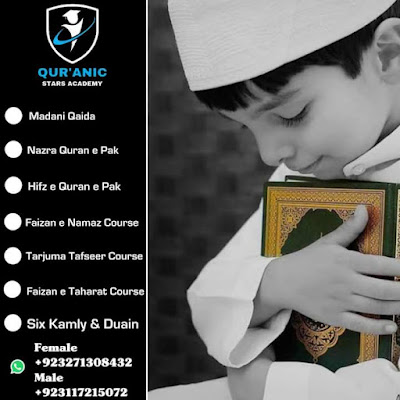Madani Qaida
is a popular educational tool used to teach children and beginners how to read the Quran accurately. The Madani Qaida course is designed to provide a solid foundation in Arabic pronunciation and proper recitation of the Quran.
1. Arabic Alphabets: Students learn the Arabic alphabet, including the 28 letters and their correct pronunciation.
2. Basic Rules of Tajweed: Tajweed refers to the rules of proper pronunciation and recitation of the Quran. The Madani Qaida course introduces students to basic Tajweed rules, such as elongation (madd), stopping (waqf), and other important rules.
3. Letter Joining: Students practice joining letters to form words and sentences. This helps in developi…
[10:30 PM, 6/6/2023] Online teacher and consultant: The Nazra Quran course is designed to help individuals learn how to read and recite the Quran fluently. It focuses on developing proficiency in reading Arabic script and reciting the Quran with proper pronunciation. The course is suitable for beginners of all ages who wish to learn how to read the Quran.
The content of the Nazra Quran course typically includes the following:
1. Arabic Alphabets: Students learn the 28 letters of the Arabic alphabet and their correct pronunciation. They practice recognizing and reading each letter individually.
2. Basic Tajweed Rules: Tajweed rules are essential for correct Quranic recitation. In the Nazra Quran course, students learn basic Tajweed rules, such as the characteristics of letters (makharij), proper pronunciation of Arabic vowels, and the rules of elongation (madd).
3. Harakat (Vowel Marks): Students learn how to read Arabic words with vowel marks (harakat). Vowel marks help in correctly pronouncing the short vowels (fatha, kasra, and damma) that are not explicitly written in the Quranic text.
4. Sukoon and Tanween: Sukoon represents the absence of any vowel sound, while Tanween represents the nasalization of the sound. Students learn how to read words with sukoon and tanween accurately.
5. Word Recognition and Reading Practice: Students are introduced to common Quranic words and phrases. They practice recognizing and reading these words to improve their reading speed and fluency.
6. Surahs and Chapters: As students progress, they learn to read and memorize short surahs (chapters) of the Quran. Surahs like Al-Fatiha, Al-Ikhlas, and An-Nas are commonly included in the curriculum.
7. Correct Pronunciation and Recitation: Emphasis is placed on the accurate pronunciation of Arabic letters and the application of Tajweed rules. Students practice reciting verses and passages from the Quran, with a focus on clarity and proper enunciation.
The Nazra Quran course is typically taught by qualified Quran teachers or Islamic scholars who have expertise in Quranic recitation. The course may be offered in Islamic schools, madrasas, or through online platforms that provide Quranic education. It is a fundamental course that lays the foundation for further Quranic studies, including memorization (Hifz) and advanced Tajweed.


